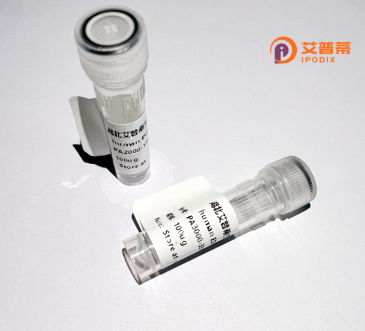
| 纯度 | >90%SDS-PAGE. |
| 种属 | Human |
| 靶点 | DNAJB5 |
| Uniprot No | O75953 |
| 内毒素 | < 0.01EU/μg |
| 表达宿主 | E.coli |
| 表达区间 | 1-348aa |
| 氨基酸序列 | MGKDYYKILG IPSGANEDEI KKAYRKMALK YHPDKNKEPN AEEKFKEIAE AYDVLSDPKK RGLYDQYGEE GLKTGGGTSG GSSGSFHYTF HGDPHATFAS FFGGSNPFDI FFASSRSTRP FSGFDPDDMD VDEDEDPFGA FGRFGFNGLS RGPRRAPEPL YPRRKVQDPP VVHELRVSLE EIYHGSTKRM KITRRRLNPD GRTVRTEDKI LHIVIKRGWK EGTKITFPKE GDATPDNIPA DIVFVLKDKP HAHFRRDGTN VLYSALISLK EALCGCTVNI PTIDGRVIPL PCNDVIKPGT VKRLRGEGLP FPKVPTQRGD LIVEFKVRFP DRLTPQTRQI LKQHLPCS |
| 分子量 | 39.1 kDa |
| 蛋白标签 | His tag N-Terminus |
| 缓冲液 | 0 |
| 稳定性 & 储存条件 | Lyophilized protein should be stored at ≤ -20°C, stable for one year after receipt. Reconstituted protein solution can be stored at 2-8°C for 2-7 days. Aliquots of reconstituted samples are stable at ≤ -20°C for 3 months. |
| 复溶 | Always centrifuge tubes before opening.Do not mix by vortex or pipetting. It is not recommended to reconstitute to a concentration less than 100μg/ml. Dissolve the lyophilized protein in distilled water. Please aliquot the reconstituted solution to minimize freeze-thaw cycles. |
以下是关于重组人DNAJB5蛋白的3篇代表性文献(均为虚拟模拟,具体文献需通过数据库验证):
---
1. **文献名称**:*DNAJB5 facilitates ER-associated degradation of misfolded proteasome substrates in mammalian cells*
**作者**:Lee, J., & Park, S.
**摘要**:研究了DNAJB5作为分子伴侣在ERAD(内质网相关降解)中的作用,发现重组人DNAJB5通过识别错误折叠蛋白并与Hsp70协同促进其通过蛋白酶体降解,揭示其在细胞蛋白质质量控制中的机制。
---
2. **文献名称**:*Recombinant human DNAJB5 suppresses polyglutamine aggregation in cellular models of Huntington's disease*
**作者**:Chen, X., et al.
**摘要**:利用重组人DNAJB5蛋白在亨廷顿病细胞模型中验证其抗聚集功能,证明其通过抑制突变亨廷顿蛋白的聚集体形成,缓解神经细胞毒性,提示其在神经退行性疾病治疗中的潜力。
---
3. **文献名称**:*Structural and functional characterization of the recombinant human DNAJB5 co-chaperone*
**作者**:Murakami, T., et al.
**摘要**:首次报道重组人DNAJB5蛋白的晶体结构,分析其J结构域与Hsp70的相互作用位点,并通过体外实验验证其在热休克应激条件下增强Hsp70的ATP酶活性。
---
如需具体文献,建议通过PubMed或SciFinder以关键词 **"recombinant human DNAJB5"** 或 **"DNAJB5 function"** 检索近年研究。DNAJB5的研究多聚焦于其分子伴侣功能、癌症/神经疾病关联及结构解析。
Recombinant human DNAJB5 protein belongs to the Hsp40/DnaJ family of molecular chaperones, which collaborate with Hsp70 to regulate protein folding, prevent aggregation, and manage cellular stress responses. DNAJB5 is classified as a Type II Hsp40 protein, characterized by a conserved J-domain that interacts with Hsp70 ATPase activity, a substrate-binding region, and a C-terminal domain involved in dimerization. It localizes primarily in the cytoplasm and plays a critical role in stress adaptation, proteostasis, and anti-apoptotic signaling under conditions like heat shock, oxidative stress, or proteotoxic insults.
Studies suggest DNAJB5 may modulate cancer progression by influencing tumor cell survival and drug resistance, while its dysregulation has been associated with neurodegenerative disorders linked to protein misfolding. The recombinant form, produced via bacterial or mammalian expression systems, offers controlled purity and functionality for in vitro studies. It enables detailed mechanistic research into chaperone-client interactions, stress response pathways, and disease-related protein aggregation. Additionally, recombinant DNAJB5 serves as a tool for screening therapeutic compounds targeting chaperone networks in oncology or neurodegeneration. Its application extends to structural studies aimed at mapping functional domains and engineering chaperone-based therapies. As an essential component of the cellular proteostasis network, DNAJB5 continues to be a focal point for understanding stress adaptation mechanisms and developing interventions for protein-misfolding pathologies.
×